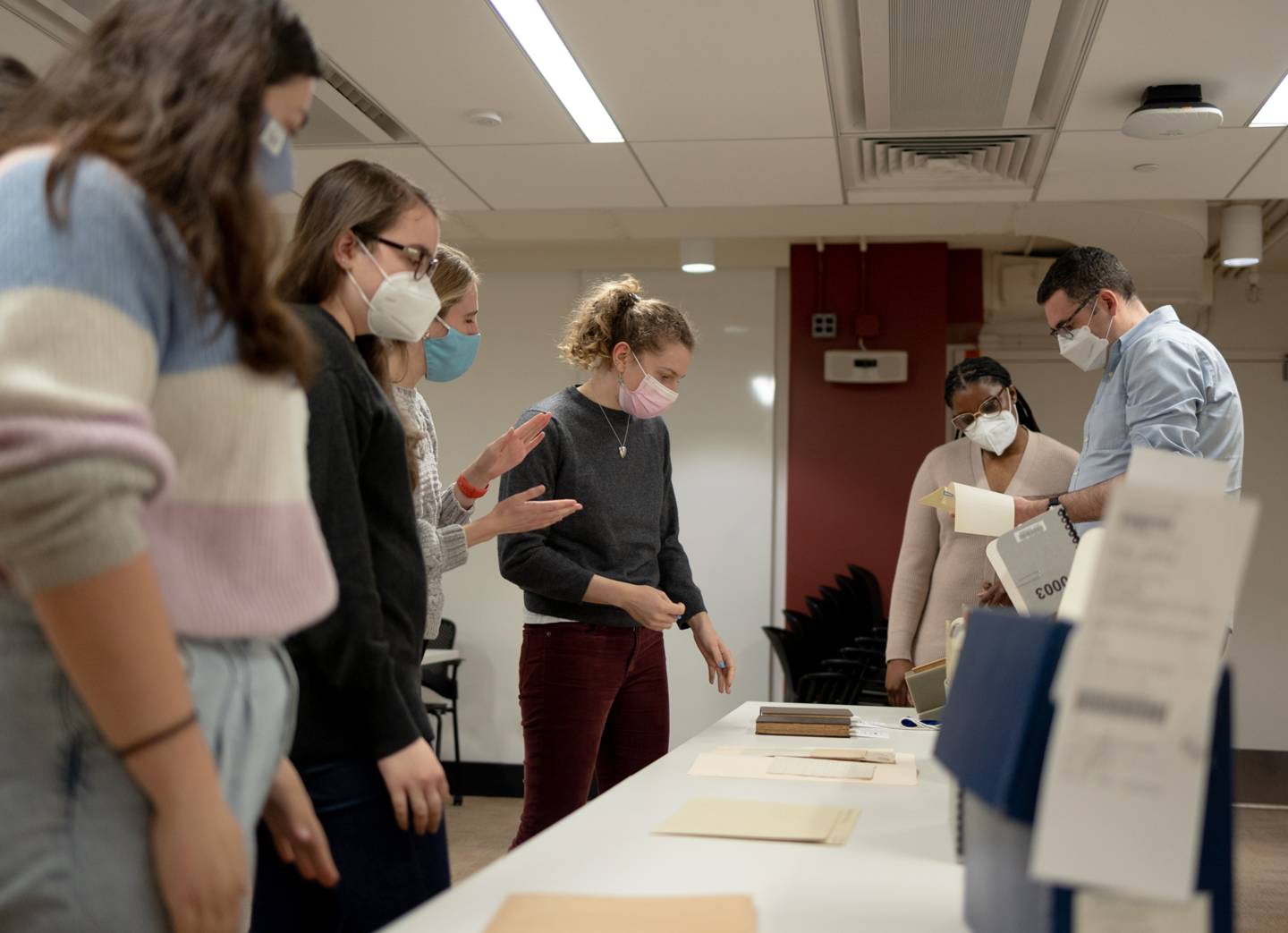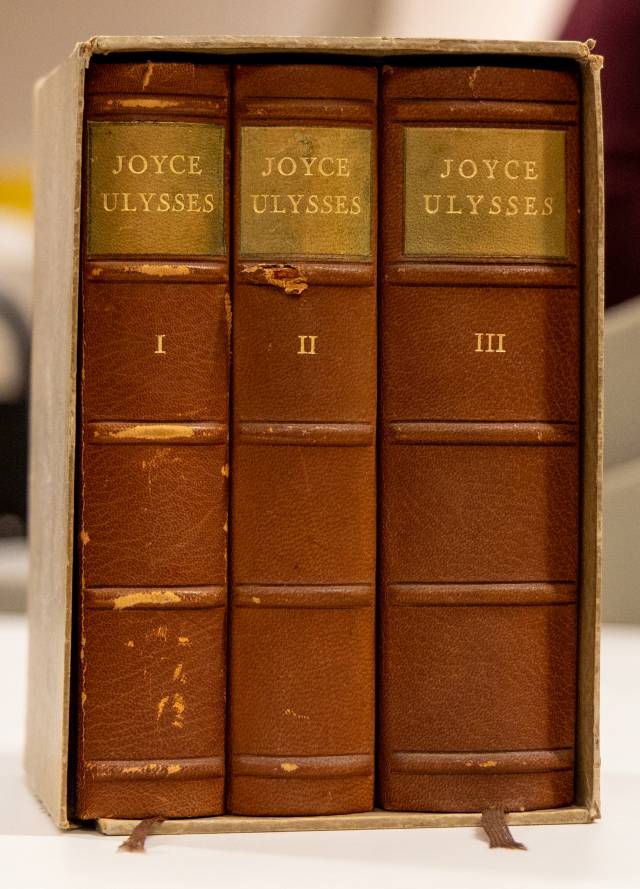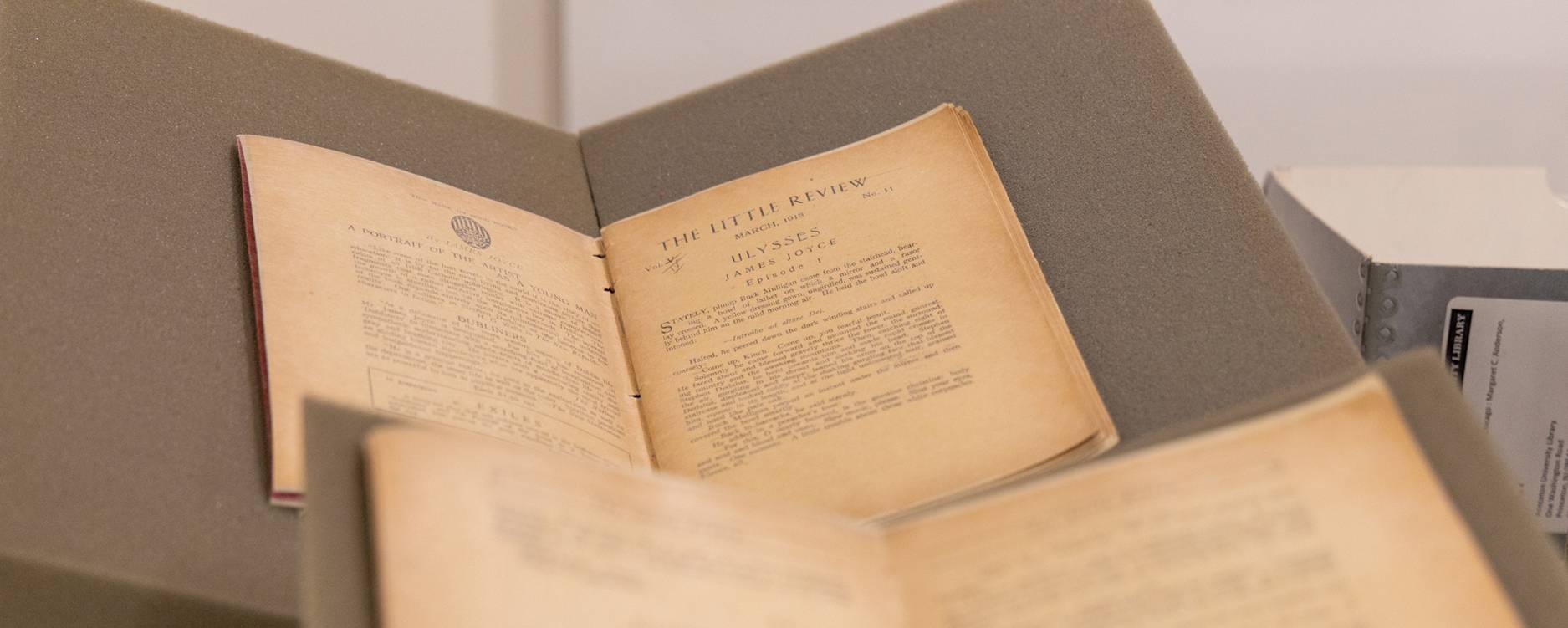Jennifer Garcon, librarian for Modern and Contemporary Special Collections at Princeton University Library (PUL), assembled several editions of James Joyce’s masterwork “Ulysses” for the spring graduate seminar, "Special Studies in Modernism: 1922." Here she examines an edition inscribed by Joyce and published by Shakespeare and Company in Paris, 1925. The edition on the left, also inscribed by Joyce, was published by Egoist Press in London, 1922.
What does James Joyce's "Ulysses" tell us 100 years later? Published in 1922, the same year the Lincoln Memorial was dedicated and the Hollywood Bowl opened, “Ulysses” is an inextricable part of the modern literary canon that’s received more than its fair share of praise (and criticism). Fans internationally mark Bloomsday on June 16, the day the novel’s action takes place.
Yet Joshua Kotin, associate professor of English, thinks we’ve only scratched the surface of what “Ulysses” has to offer. His graduate seminar, “Special Studies in Modernism: 1922,” explores James Joyce’s work as well as contemporary publications from T.S. Eliot, Virginia Woolf and Claude McKay in consideration of their influence 100 years later.

Josh Kotin (far right), associate professor of English, designed the seminar to explore Joyce’s work as well as contemporary publications from T.S. Eliot, Virginia Woolf and Claude McKay in historical context. Also pictured: Graduate students Mary Kate Guma (English), left, Lauren Bunce (English), Chloe Wheeler (comparative literature) and Grace Monk (comparative literature), and librarian Jennifer Garcon.
“This class presents a way to think about modernism and to reflect on the importance of that year,” Kotin said.
Sparked by the centenary of the publication of “Ulysses,” Kotin feels that modernist studies is due for a renaissance. Beyond wanting his students to glean the literary significance of the course texts, Kotin emphasizes the process of contextualizing literature as part of a larger, historical conversation.
“I wanted them to think about what context is — we were always told to contextualize literature but I’m not sure anyone really knows how to define that process,” Kotin said.
To that end, Kotin enlisted the help of Jennifer Garcon, librarian for Modern and Contemporary Special Collections at Princeton University Library (PUL), who handles the collection, curation and care of 20th and 21st century materials. Kotin and his students made several visits to PUL’s Special Collections during the spring semester.

This German three-volume set of James Joyce’s “Ulysses,” part of PUL’s Special Collections, was published by Privatdruck in Basel, Switzerland, 1927.
Garcon supported the class by calling up numerous copies of Joyce’s “Ulysses” from the library’s Sylvia Beach Collection. Beach, an American bookseller in Paris, first published “Ulysses” in 1922 at her bookshop and lending library, Shakespeare and Company, which she founded in 1919. The shop became a meeting place for French, English, American, Irish and other writers — among them James Joyce — from the 1920s to the 1930s.
The Beach Papers, acquired by PUL in 1964 and held in Firestone Library, document much of Beach’s life and activities. The collection includes material related to Beach’s publications of James Joyce’s works, most famously the controversial “Ulysses,” which was banned in Britain and the United States until the mid-1930s. The collection also includes extensive records related to Shakespeare and Company, correspondence to and from authors such as T.S. Eliot, Allen Tate, Richard Wright, George Antheil and D.H. Lawrence, and Beach’s personal materials, photographs, writings, artwork, manuscripts and memorabilia.
“The students have been able to see different editions of ‘Ulysses,’” said Garcon. “They've been able to see it serialized, in its initial publication in the small magazines. They've been able to touch and handle the objects themselves. And because of the variations in the way it’s been printed, and the financial constraints of the publishers at the time, they can see a visceral difference in the material over time as well.”
Looking at ‘Ulysses’ in the context of the 1920s, creating new scholarship
Kotin’s class also centered on the dichotomy between the sheer volume of commentary about Joyce’s work and the still untapped potential of archival reserves.
“On one hand we’re diving into the middle of a million conversations about these canonical, important, influential books,” Kotin said. “On the other hand, we want to use the archives at Firestone to think about the potential of artifacts and texts and unpublished material that hasn’t been looked at. How can those two sides of the story speak to one another?”
As researchers, Kotin and Garcon frequently returned to the question of how to build new collections using the materials pulled from the archives.
“We’ve discovered things together that we didn’t know were in Special Collections and recognized gaps to be able to say, ‘It would be great if the library could acquire material in this area,’” Kotin said. One such resource was letters by Black modernist authors such as Paul Laurence Dunbar, Ralph Ellison and Richard Wright, which they found almost entirely in the archives of white editors and poets.
“So now, we have to think about how to build collections that are more than miscellaneous letters,” Kotin said.
The graduate students and two members of the Class of 2022 who received special permission to take the seminar were also tasked with looking through PUL’s archives and finding something — anything — that has yet to be published and writing about it. The project was based on the “Little Known Documents” section of PMLA — the journal of the Modern Language Association of America — in which scholars curate archival material on unpublished documents.
“Initially, I was surprised by how difficult archival work can be,” Kotin said. “What does it mean to look at a letter, or even to know where to look? There are just so many options in Firestone because it’s such a rich collection that the students had a hard time knowing where to look and how to understand the item they are trying to look at.”
“I took this class just because I wanted a chance to examine canonical texts, and I also was really drawn to this component of working with the archives,” said Grace Monk, a first-year graduate student in comparative literature. “It’s not something many graduate classes do, though I think it’s something that a lot of people are expected to do as part of their dissertation but don’t really have an introduction to before that.”

This serialized edition of James Joyce’s “Ulysses,” part of PUL’s Special Collections, appeared in the magazine The Little Review, March 1918, published by Margaret C. Anderson in Chicago.





